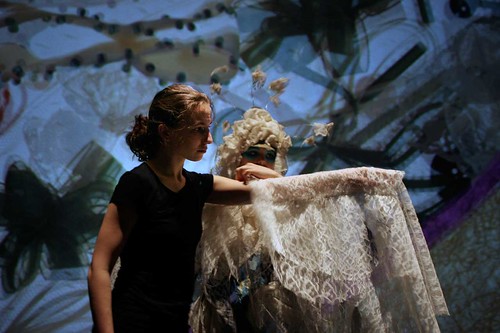A scientist wearing lace wings paces about the stage, while a blue-and-white “bird spirit,” also costumed in lace and feathers, sings her a birdcall. All the while, animations of cellular processes unfold on the dome above their heads. Needless to say, this was not your average science lecture.
Anna Lindemann’s production of Theory of Flight, a multimedia performance blending art and science, was performed February 17 and 18 at Colgate’s Ho Tung Visualization Lab, to full audiences. The hourlong show depicts a scientist’s experiments on her own body that go awry as she becomes half-bird, half-woman in an attempt to grow wings.
The production, directed by Alex Borinsky, featured Lindemann as the scientist and soprano Lucy Fitz Gibbon as the bird spirit. The final performance was followed by a “Flying Feast” — a multi-taste experience inspired by the avian world concocted by Ellie Markovtich and Rose Mitchell.
Lindemann, a visiting assistant professor in the art and art history department at Colgate, said the show is “intended to be an emotionally gripping and intellectually challenging experience.”

Nothing in Theory of Flight has just one creative force behind it; rather, Lindemann integrated music, performance, animation, and evolutionary developmental biology. She hopes her audience will be “encompassed by a world of fantasy” while still learning something scientifically concrete about the micro and macro processes that go on in the bodies of birds and humans — for example, the biological processes of limb growth and the evolutionary origins of flight.
Lindemann, whose scholarly background includes evolutionary biology and ornithology, as well as integrated electronic arts, created Theory of Flight as her MFA thesis at Rensselaer Polytechnic Institute. Part of the inspiration for the show came from her studies of eminent biologist John Saunders’s evolutionary experiments, which were, as she put it, “fabulous fodder for artistic projects.”
The bird songs that Lindemann spent a summer recording in Indonesia inspired some of the music she composed for the show, and she represented DNA and cells through the animation of yarn and buttons projected on the dome of the Viz Lab.
Theory of Flight performances and the Flying Feast were sponsored by the Colgate Arts Council as part of their series of interdisciplinary events in the arts and sciences. The audience also represented a blending of the arts and sciences.
Students from biology, film and media studies, and studio art all attended the shows, including those taking Mary Simonson’s Female Filmmakers seminar and Ray Watkin’s Scientific Investigations of the Animal Mind, a Core Scientific Perspectives class.
Even students who were not required to come for a specific class connected the show with their studies. Senior Carolyn Fox said she saw a crossover of themes with her environmental science class: “the connection came from exploring how complex and dynamic systems in the environment are similar to the complicated systems of limb growth and flight like those explained in Theory of Flight.”
MORE
Lindemann will give a lecture describing the creation of Theory of Flight as part of the Art and Art History Lecture Series at 4:30 p.m., February 29, in Golden Auditorium, Little Hall.